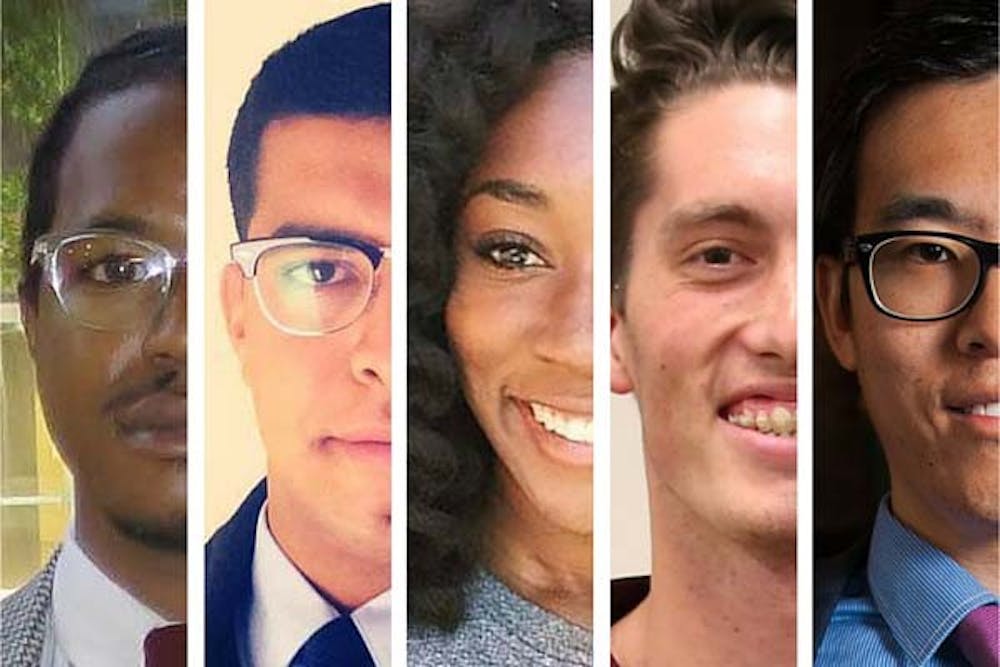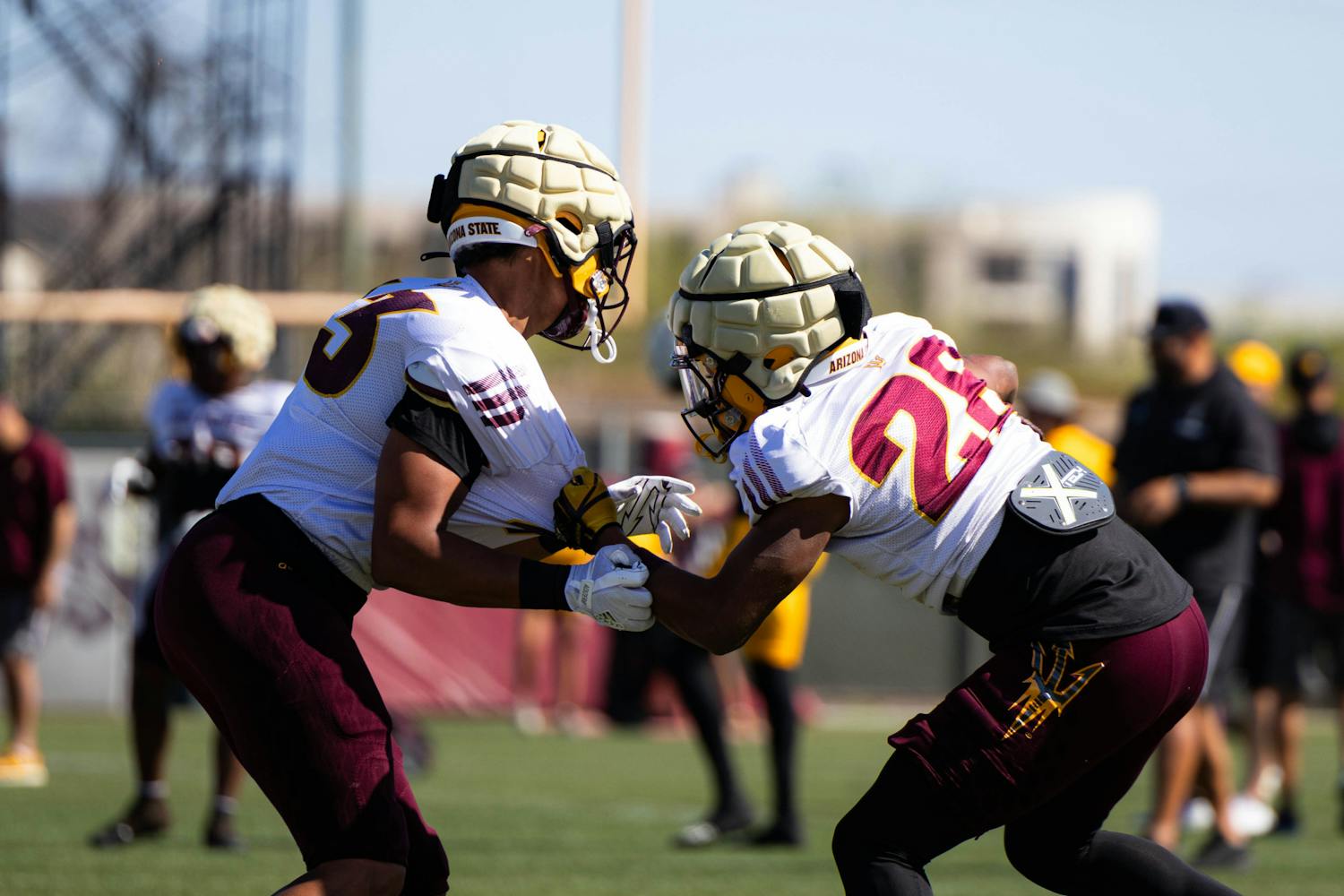As ASU becomes a statistically more diverse school, some minority student groups and organizations feel the campus is an alienating environment — one with the intent of making everyone feel welcome, but that hasn't fully delivered on its promise.
It's a theme seen across the the country — not just on college campuses, but in Congress, state governments and Hollywood — that minorities are sorely underrepresented and outnumbered by their white counterparts.
However, exploring the atmosphere for minority students at this college campus can provide a window into what the rest of the U.S. is like for people of color, and perhaps explain from where these isolating feelings are coming.
"It is hard to determine what it is, but I think it’s racism."
In January of 2014, the Tau Kappa Epsilon fraternity was kicked off the campus for hosting a Martin Luther King Jr.-themed party. Attendees posted pictures of themselves drinking out of watermelon cups and dressed as “thugs” in basketball jerseys and baggy clothes.
Ja’han Jones, an African-American ASU alumnus, wrote an article about this fraternity party that went viral in 2014. Almost two years later, he's working at "The Today Show" in New York.
"It may seem to many people as this benign issue," he said. "It’s one organization at this very large institution that’s having this one greatly offensive party. As far as I’m concerned, there may not be many MLK black parties taking place, but there’s just a certain hostility that black students experience that may not even be intentional by their white counterparts."
Civil rights activists outraged about fraternity party from The State Press on Vimeo.
Naya Okeke, president of the National Pan-Hellenic Council, which is the governing body for African-American fraternities and sororities on campus, said she experienced discrimination from TKE even after this MLK party.
"We went to an apartment," she said. "It was just a party my friend knew about. We wanted to go in and they said, 'No, you guys can’t come in.' We were like, 'Why not?' And then I look inside, and it's a little TKE headquarters."
Okeke added that even though ASU has permanently revoked TKE's recognition as a chapter, its members still have a presence at the school.
"I see them all the time," she said. "I don’t understand why they’re still on this campus. I kind of wish they were gone, just because I know people that have had issues with them and just don’t feel safe with them around."
Following that incident came a jaywalking altercation in June 2014 in which an African-American professor, Ersula Ore, was thrown to the ground by a police officer, sparking a debate across the nation about whether law enforcement overstepped its boundaries.
In October 2014, some students went to a "black-out" football game with their faces painted black, prompting an age-old dialogue across the campus over the offensive nature of blackface and how it affects the African-American community.
Rashaad Thomas, an African-American Air Force veteran, husband, father, artist, poet and justice studies senior, said he thinks a lack of education among ASU students spurred this incident.
"You can voluntarily choose not to wear blackface and end up going to the game, but there's not enough education on the problematic issues through history of what race and color and blackface has done to a people," he said.
In January 2015, a white supremacist group called the National Youth Front, not affiliated with ASU, put anti-Islam and anti-immigration flyers across the campus, continuing to protest for months afterward.
In April, a different group of protesters, again not affiliated with ASU, tore up the Quran and spat on the holy book in front of the Islamic Community Center of Tempe.
Eyad Alzahrani, a Muslim justice studies sophomore from Saudi Arabia, said this type of behavior stems from a skewed view of terrorism and the World Trade Center attacks in 2001.
“Some have a bad idea from 9/11, though I believe (Saudis in this country) are not related to that, especially if you saw how Saudis used to live in this country before 2001 and 9/11,” he said. “Terrorist groups around the world under the name of Islam don't represent even 2 percent of Muslims, so why focus on these groups rather than focusing on the 98 percent of the whole population of Muslims around the world?"
Then in October, an ASU student posted a picture of herself on Twitter, posing by a cotton field with the caption, “Our inner n----r came out today.”
Native American lawyer and professor Rebecca Tsosie, became the ASU vice provost of the Office of Inclusion and Community Engagement in July, and pointed to a contributing factor to the frequency of incidents.
"Anytime you have a student body that large, you’re going get people in the mix who are basically reacting to certain social events," she said. "They can be highly disrespectful, but the face-to-face encounter is actually the beauty of a campus environment, because what we’re building at ASU is a community, and we need people to be able to interact with each other."
These types of incidents at ASU have frequently made headlines, but there's even more happening on campus that doesn't always become national news. These smaller incidents go unnoticed by mostly everyone involved, except for the those on the receiving end of these situations.
Alzahrani mentioned an interaction he had with a drunk, white student on Mill Avenue after a dinner with friends.
“He looked at us and said, ‘Go back to your f-----g country; you’re a f-----g terrorist,’” Alzahrani said. “I was shocked, but at the same time, I couldn’t blame him because of the media in this country.”
This wasn't a singular event. Most of the time, he said he experienced smaller acts of racism, known as microaggressions, on ASU's campus.
"One day, I was having a class in a building I’d never been in, and I was asking the first guy that comes in my sight for help to find the class,” he said. “He didn’t even answer the question. He just gave me this look. It is hard to determine what it is, but I think it’s racism. There is no other explanation you can put to it.”
Thomas, like Alzahrani, has experienced racism near the campus. One time, a white student shouted profanity at him while he was walking with a woman who also happened to be white near the campus.
"A young man peeled his car at the corner of Mill Avenue and University toward us, rolled his window down and said, ‘Hey n----r, leave our white women alone,’” Thomas said. “It wasn’t my first time I’d dealt with racism here in Arizona, but it was something that connected me with Arizona State University.”
Demographic breakdown: "We do exist, but I don’t see it."
ASU is a predominantly white campus with about 55 percent white undergraduates in the spring 2015 semester. This can feel overwhelming when you are a person of color and face these numbers on a daily basis.
"You only see one or two black students in a classroom,” Thomas said. “I don’t have a problem in saying that I want to go to a room or space where I can see myself because I don’t see it Monday through Friday, 9 to 5, when in my classes. I don’t see it when I’m walking through campus. We do exist, but I don’t see it.”
On ASU’s diversity homepage, an array of accolades is on display, showing how far the school has come in making its campuses a more inclusive environment for minority students and faculty.
The school had more minorities enrolled than ever in its 2015 freshman class with 39 percent. Since 2005, there has been a 156 percent increase in degrees given to minority students.
Counseling psychology graduate student German Cadenas said it is a campus full of acceptance and welcoming gestures. However, he only gained his citizenship at the beginning of graduate school and was an undocumented DREAMer student throughout his undergraduate career, which he said added a bit of difficulty to his experience.
“I could not drive, vote, get in-state tuition or get government financial aid due to my immigration status,” he said. “The difficulties were not caused by ASU, but rather caused by our outdated immigration system.”
As far as experiencing racism and discrimination, Cadenas said it was not something that came to mind while he was on campus.
“Professors, staff and students at ASU have always been welcoming to me since I enrolled, and I don't think I have been treated differently because of my immigration status,” he said. “I have been treated with respect, as an equal human being.”
There is a chance that Cadenas was seeing more of himself throughout his time at ASU than an African-American student might see him or herself. The undergraduate population of Hispanic/Latino students in the Spring 2015 semester was nearly 20 percent while the African-American undergraduate population was just under 5 percent.
A Chinese ASU doctoral alumnus, “Tiger” Hu Duan, who is writing a safety guide in response to the road-rage killing of Chinese student Yue Jiang, also shared positive feelings about his experience as a minority student on campus.
“ASU is really open to students from other countries,” he said. “I felt welcomed here. People here seldom refuse other people, which is good. But for an international student, if you want to have a deeper relationship, you definitely need to put in more effort for it to be formed.”
The Asian undergraduate student population of ASU is close to the African-American population number, with about 5.5 percent.
Duan said his experience as a Chinese minority student will be different than African-American students because the Chinese and other Asian demographics have different experiences than those of other discriminated ethnicities.
"From history, we can tell that the U.S. had a really good attitude to the Chinese already," he said. "There’s no reason to say why the current Chinese student would not feel welcome again."
There is also a lack of African-American faculty within many of ASU's specific schools and colleges. There are six African-American professors teaching at the Mary Lou Fulton Teachers College, though ASU did not specify how many professors teach in the college. Also, three out of 45 faculty members at the Walter Cronkite School of Journalism and Mass Communication are African American.
Yet Christopher Callahan, the founding dean of Cronkite and an ASU vice provost, said the school is reflecting a high number of African Americans when compared to the African-American population of Arizona, which is about 3.5 percent.
"Within Cronkite, in terms of diversity of faculty, in general, we’re about a 25 percent people of color, which was 10 percent a decade ago," he said. "Great progress, with still a lot more to come."
Last year, ASU boasted that it has the most diverse faculty of its history, yet minority members only contributed to 23.5 percent of the faculty on campus.
Elizabeth Swadener, professor of culture, society and education / justice and social inquiry and co-founder of the peace advocacy and anti-racism group Local to Global Justice, said this number is deceptive.
“There are still many programs of which the faculty are predominantly white and predominantly male,” she said. “I don’t think we’ve achieved the as-inclusive or as-representative demographics as we should have.”
Vice Provost Tsosie said this lack of African-American faculty comes from the highly competitive market for jobs in academia.
"We can’t hire enough faculty to fill all the needs that we have across the campus, so when a department gets a line to hire, those are incredibly rare opportunities and the field of people that apply for them is huge," she said. "What you’re dealing with nationally is a really tight market, a lot of highly qualified applicants and multiple needs for substantive knowledge as well as to actually have a faculty that represents the society that we come from. I personally would love to have much more diversity."
Still, Swadener said this can create a sense of alienation among African-American students and makes for a “chilly climate” on campus that is not as welcoming as it should be.
“You can go to certain schools like ours and point to the diversity, but we are surrounded by a sea of white,” she said. “I think we need to address that. I just really would like to see more money where our mouth is about creating safer and more welcoming spaces for our students and also programs that are aimed at students, when you talk about people of color.”
However, Swadener said not all facets of diversity on campus are a negative.
“Something positive about ASU is the number of first generation students we have and the number of DREAMers that have found a way to come here,” she said. “Our commitment isn’t just to excellence, but excellence with inclusion, and I don’t think it’s just public relations saying that. I really think that is their intent.”
Student programs: "These organizations are extremely important."
ASU offers student programs such as the Black African Coalition, which houses smaller clubs including the African American Men of ASU and Zaria, the female equivalent of AAMASU, that help provide the safe spaces that Swadener mentioned above.
Yet Thomas, who transferred to ASU from Scottsdale Community College, said not all African-American students are aware these programs exist.
“You can have all these clubs in the MU, but I didn’t know that,” he said. “Those things are all well and good for the people that live on campus, but not for a non-traditional student.”
Okeke agreed with this statement, but said if a student wants to find these types of clubs, they will have to seek them out for themselves.
"For some students, it’s extremely hard if you don’t know anyone who are in those organizations, especially if you are a transfer student or a freshman from a different state, but the resources are there," Okeke said. "If you look for it, you’re going to find it."
In addition to being the president of the NPHC, Okeke also founded a student organization last fall called the Black Medical Students Association. Its goal was to bring together African-American individuals that share a common interest within the health and medical field.
"People will say, 'I’m the only African American in my class,'" she said. "But for me, I’m a science major. There really is not many of us in there, so that’s why I started (the BMSA) so we could have a place for like-minded people."
Okeke added the role these groups play for African-American students have become essential to her college experience.
"I often think about what would I have done if I didn’t have the BAC or the organizations I’m in," she said. "I don’t know where I would have been. These organizations are extremely important."
However, she also talked about struggling to gain funding to promote the BMSA, a problem that many of the organizations have faced.
"A lot of the problems with organizations underneath the BAC, the predominantly black organizations, is that we don’t have money to do things," she said.
Ja'han Jones was the president of AAMASU before graduating and moving to New York. He also talked about experiencing a loss in funds while participating in these student organizations.
"I’m sure the University would say, 'Well we have these student organizations that exist for African-American men and women,' and this is true, but the fact of the matter is that these organizations have been gradually losing funding," he said. "So it’s difficult for the University to claim that they have an interest in the prosperity of its students of color when they are also cutting their resources."
Simone Jackson is a facilitator for Zaria and president of the Alpha Kappa Alpha sorority. She said the organization also struggled to find funding.
"Major events aren’t being appropriated until three days before, and we literally have to go without marketing because it’s being overlooked," she said. "I want to have as much importance on my event as you would for any big program to bring in that diverse crowd that ASU wants."
Tempe Undergraduate Student Government President Isaac Miller said the goal is for all clubs to have equal funding, though it depends on the specific appropriation policies and appropriation senators to decide how much money an organization receives.
"We try to make it as equitable as possible," he said. "This year’s appropriation senators, I think, are very fair and they’re trying to be as conservative as possible to try and benefit as many students as possible with the limited appropriations funds that we have."
Tsosie said she meets with students all the time and approves many cultural heritage requests, yet Okeke said Tsosie's name doesn't ring a bell.
"If she’s the head of diversity and I’ve never heard of her, and I’m pretty involved with the Black and African Coalition at ASU, that means something," Okeke said. "I would love for her to come and talk to us. I haven’t personally met her.”
Tsosie responded to this, saying that her office has changed four times within the past four years.
"The name of the office has changed," she said. "The portfolios changed. It’s not even within the realm of reason to expect people to know who I am. ... I am available to meet with student organizations, but none of them as an organization have come to meet me or invited me to meetings."
“I want to be somebody that incites change"
Racism in the U.S. may feel like an insurmountable problem to solve. However, steps can be taken to change a predominantly white campus such as ASU into one that is more inclusive and accepting of all backgrounds.
Thomas recalled the incident in which he was called the N-word, leaving him with a desire to impact the ASU community. He said he aimed to change the ignorance of screaming this type of word on a crowded street corner.
“I want to be somebody that incites change, because if somebody that is this young and has this much ignorance to yell out this in front of all these people, then what is this university doing to teach these young people to be that change? To avoid this so called ignorance that they’ve just been injected with throughout their lives?” he said.
Thomas said a first step in battling racism would be to eliminate the idea that African Americans must remain silent in their plight against inequality and discrimination. He said he is tired of hearing certain phrases when he speaks up about issues of racism.
“'Words are just words.' 'You’re making color out to be so bold.' 'All lives matter,'” he said. “It’s just not true. Until we realize that, as a campus at ASU, that’s when we’ll start affecting not only young high school students, but also students that graduate, people that become part of the community, business owners and politicians."
"When you start creating change at the education level, that’s when we’ll see a difference in the community," Thomas added. "Until then, it will still be the same, and we’ll continue having this banter.”
Tsosie said diversity has already made its way to ASU, and now inclusion needs to be focused on more.
"What do we do to promote respect for other cultures?" Tsosie said. "That’s going to be a product of what you’re exposed to, and what the policies are that actually guide you. Our (ASU) policies do require a level of respect between students, between students and faculty, so our norm is one of respect and cultural exchange."
She said when she teaches constitutional law in an ASU classroom, she doesn't shy away from bringing up heavy topics such as race, which helps educate students about this idea of cultural respect.
"There are professors that say, 'I wouldn't want to talk about race because that's too controversial," she said. "I don't. I tell (students) day one, 'We're going to talk about race, we're going to talk about gender, hate speech and discrimination. You need to know what this is.'"
It's the same with Alzahrani and his experience of being a Saudi Arabian Muslim on campus. While the correlation of his Islamic religion to terrorism in some Americans' minds seems troubling, he has a positive outlook.
“It’s complicated to judge people depending on their religion or depending on their background or their color,” he said. “It is something you shouldn’t do because in the end we all are humans. We all have been created differently so we can discover each other. This is the reason why I came to this country.”
Jones said creating an inviting environment for African-American students will not happen by solely bringing in people from more diverse backgrounds.
“Arizona State needs to understand that developing a hospitable culture for African-American students isn’t something that just happens by accident,” he said. “It’s not even something that happens by bringing in more black students. It needs to be intentional."
"You need to have more black faculty members and you need to have more faculty members with some sort of cultural competency," Jones added. "You need to have programming that’s intentionally black, unapologetically black, because that’s the sort of culture that allows black students to feel comfortable.”
Jones said while he may seem negative, he is only a realist who wants to set the record straight about what it’s like being an African American at ASU.
“I think there’s just some very realistic discomfort to being a black student at a predominantly white institution that isn’t really designed to see you succeed,” he said. “But I’m fine. Blackness in the United States instills within you this necessity to stay afloat because none of the institutions around us are designed to see us succeed.”
Miller said if students feel alienated, they are welcome to come talk to him and other USG representatives because he and his fellow representatives can reach the administrative officials such as ASU president Michael Crow.
"I know that there may be some sentiments that people have about feeling disenfranchised," he said. "I want them to know that I’m all ears. USG is all ears. If they want to talk about that and vet about that. ... If I don’t get to hear from you, then I can only say so much."
While there may not be a definitive resolution for the reality of race relations at ASU and beyond, Jones said ASU still has the proper funds to make the campus more welcoming.
“The University is the institution that has all of the resources necessary to make all minorities feel comfortable,” Jones said. “I guess it ultimately comes down to if they feel that as a priority of theirs.”
Reach the investigative reporter at jhgolds2@asu.edu or follow @_jacobgoldstein on Twitter.
Like The State Press on Facebook and follow @statepress on Twitter.





